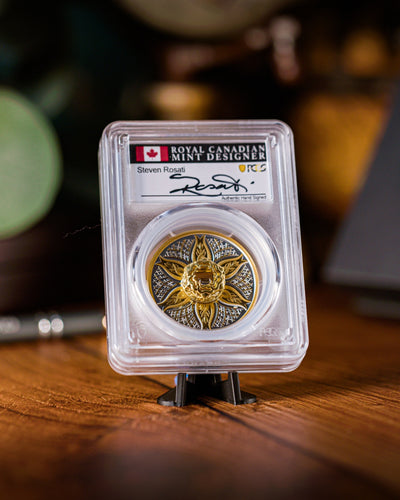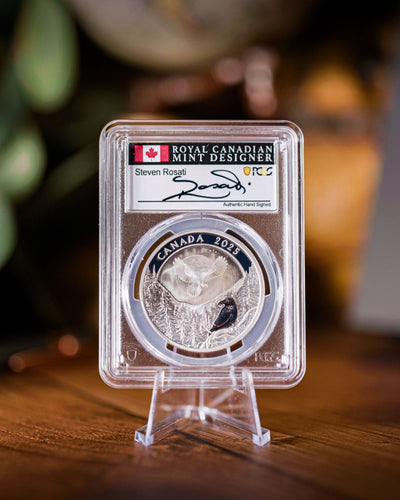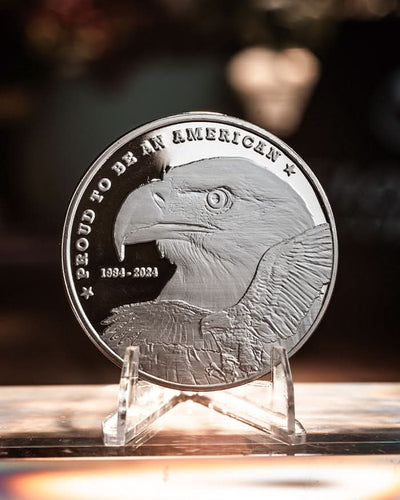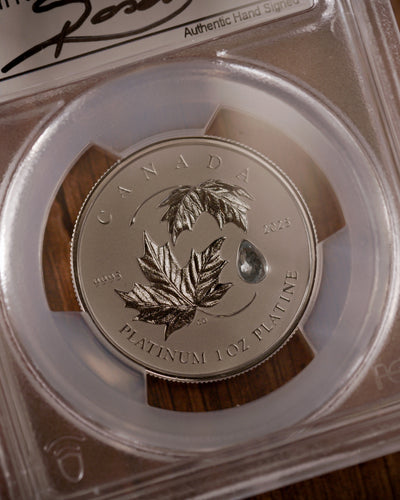Gold Bars vs Coins: The Ultimate Buying Guide
Buying Silver Bars vs Coins: The Ultimate Guide Trying to decide between gold bars vs coins? Gold bars are cost-effective for large scale investments, while gold coins offer collectible and historical value. This guide will explore the key differences...

Buying Silver Bars vs Coins: The Ultimate Guide
Trying to decide between gold bars vs coins? Gold bars are cost-effective for large scale investments, while gold coins offer collectible and historical value. This guide will explore the key differences in precious metal investing to help you make the best choice.
Key Takeaways
-
Gold bars and many silver coins are typically preferred for large investments due to lower premiums and higher purity, whereas gold coins offer collectible value, a face value, and often come with higher premiums. Silver bars, especially larger sizes, may be a better investment for those seeking cost efficiency and long-term gains.
-
Retail investors should be aware of tax implications, as physical gold (bullion or coins) is classified as collectibles and subject to a maximum capital gains tax rate of 28%.
-
Choosing between gold bars, coins or large silver bars should be based on personal gold or silver investment goals, considering factors like cost, liquidity, and storage needs.
Understanding Gold Bars and Gold Coins

Gold bars and gold coins are two primary formats of holding physical gold, each with its own characteristics. A gold bar is an unmonetized bullion, typically available in standardized weights, making it easier to evaluate its purity and value. On the other hand, a gold coin is monetized and was once legal tender, adding a layer of historical and collectible value. Both formats are popular among retail investors looking for a reliable gold or silver investment that serves as a hedge against inflation and provides portfolio diversification.
Knowing the basic differences between gold bars and coins is essential. While gold bars are often preferred for large investments due to their lower premiums, gold coins can carry additional value from their collectible nature and legal tender status. Government minted coins often feature intricate designs and guaranteed silver content, which can enhance their investment potential. This guide will delve deeper into these aspects, helping you weigh the benefits and drawbacks of each option.
Market Trends and Demand
The demand for silver coins and silver bars is shaped by a variety of market trends, making silver a dynamic and attractive option for investors seeking to diversify their portfolios with precious metals. Economic uncertainty, inflation, and global geopolitical events often drive investors toward physical silver, which is widely regarded as a safe-haven asset during periods of market volatility. This strong market demand is especially evident in the retail market, where popular silver bullion coins like the Royal Mint Britannia and Canadian Maple Leaf consistently see high liquidity and recognition among both collectors and investors.
Silver bars, particularly larger silver bars, are favored by those looking to make bulk silver purchases due to their lower premiums and cost efficiency. For investors aiming to build substantial silver holdings, these bars and coins offer a practical way to acquire physical precious metals at a lower cost per ounce compared to many silver coins. The appeal of silver bars is further enhanced by their straightforward pricing structure and the ability to invest in larger increments, making them an attractive option for those with long-term silver investment goals.
Government mints, such as the US Mint and Royal Mint, play a crucial role in maintaining the credibility and quality of silver bullion coins, while private mints expand the range of available silver products, including non-legal tender bars. When buying silver, it’s important to consider factors like purity standards, weight, and authentication to ensure the integrity of your investment. Reputable mints and professional storage solutions, such as high-security vaults, add an extra layer of confidence for investors seeking to protect their physical silver assets.
Market value for silver coins and bars is influenced by several factors, including spot price fluctuations, production costs, and the performance of other precious metals. As a result, staying informed about current market trends and developments is essential for maximizing the potential benefits of your silver investments. Additionally, tax implications can vary: in certain jurisdictions, silver coins may offer tax advantages such as exemptions from capital gains tax, while non-legal tender bars may incur taxes. Understanding these legal considerations can help investors make more cost-effective and tax-efficient decisions.
Ultimately, whether you choose to invest in silver coins or silver bars, prioritizing cost efficiency, security, and authenticity will help you make the most of your silver investment. By keeping an eye on market demand and trends, you can position your investment portfolio to benefit from the distinct advantages that physical precious metals offer in today’s ever-changing financial landscape.
Key Considerations for Buying Gold Bars
When considering buying silver coins or gold bars, several key factors come into play, including purity, size options, and gold or silver investment benefits. Silver bars typically have lower production costs, which means investors pay lower premiums per ounce, and they often display serial numbers to verify authenticity. Smaller gold bars generally come with lower premiums compared to coins, making them a cost-effective choice for larger investments.
Here, we’ll examine these considerations to aid in your decision-making, noting that silver bars offer investors high precious metal content and cost efficiency.
Purity and Size Options
Investment-grade gold bars typically boast a purity of 99.99%, representing the highest standard in the retail market. This high level of purity ensures that you are getting a valuable asset that can appreciate over time. Gold bars & most silver bars are available in a range of sizes. This diversity caters to different investment strategies. From small 1-gram bars to large 400-ounce bars, there are options to suit every investor’s needs. Larger bars are generally more cost-efficient and require less space for storage, making them suitable for large-scale purchases, while smaller bars often have lower mintages, which can increase their rarity and desirability among investors.
Gold bars typically have their purity engraved on them, ensuring their quality. This makes them a preferred choice for those looking to invest in precious metals with confidence. Whether you are aiming for a substantial investment or small gold bars for a smaller, more manageable amount, the size options available in gold bars can accommodate your investment objectives.
Investment Benefits
A major benefit of gold bars or other precious metals is their lower premiums compared to gold coins. This cost-effectiveness makes gold bars an attractive option for long-term investments. Many investors choose to invest in silver bars as they are often considered a better investment due to their strong investment potential. Additionally, the high purity of gold bars can enhance their value over time, making them a reliable investment.
Gold bars or silver bars tend to be an excellent fit for strategies aimed at reducing additional costs. With lower premiums and manufacturing costs, gold bars offer a favorable pricing structure for those looking to maximize their returns. This makes them a strategic addition to a diversified investment portfolio, particularly for those with long-term investment goals.
Key Considerations for Buying Gold Coins

Gold coins or silver items offer a different set of considerations compared to gold bars. While they also serve as a form of gold investment, their collectible nature and legal tender status add layers of value, similar to popular silver bullion coins, collectible coins or gold coins and gold sovereign. Silver coins, in particular, have a face value established by the mint, can be purchased in smaller increments such as fractional sizes, and in some cases, profits from their sale may be tax-free, especially when certain coins are exempt from capital gains tax.
We’ll explore key factors like numismatic value and collectability when buying silver coins or gold coins.
Numismatic Value
Gold coins often carry intrinsic numismatic value, which can significantly enhance their appeal beyond the metal's value alone. This numismatic value is driven by factors such as rarity, historical and traditional value, and demand among collectors. For instance, vintage gold coins can appreciate in value substantially over time, providing a lucrative investment opportunity.
Numismatic value can cause gold coins' market value to exceed their melt value, especially when in strong market demand. This potential for appreciation makes gold coins an attractive option for those who value both the investment and collectible aspects of precious metals.
Collectibility and Legal Tender
Collectibility is another important factor when considering gold coins. Many gold coins attract collectors due to their aesthetic appeal, historical context, and rarity. This adds an additional layer of value, making them more than just an investment in precious metals, but a strategic asset in the broader precious metals market.
Furthermore, the status of gold coins as legal tender provides an added layer of security. This recognition as legal tender by government mints instills trust and confidence in the investment, ensuring that gold coins are a reliable and secure option for retail investors.
Pros and Cons of Gold Bars

Gold bars offer significant investment advantages but also present certain challenges. Storage and transportation can be difficult, and retrieving silver bars from secure storage may require complex authenticity checks to verify their legitimacy. Weighing these pros and cons, especially in the context of buying gold coins vs silver coins or buying silver bars vs coins and other gold or silver investment options, can help you make an informed decision tailored to your circumstances and strategy.
Advantages of Gold Bars
A key advantage of gold bars is their lower premiums compared to gold coins, making them cost-effective for bulk silver purchases. Additionally, gold bars usually have a higher purity level, which can enhance their value over time.
Lower premiums and high purity make gold bars an appealing gold bullion investment choice. Alongside bullion coins, they are ideal for long-term holdings and can be a cornerstone of a diversified investment portfolio.
Disadvantages of Gold Bars
However, gold bars also come with their own set of challenges. Their size and weight make storage and transportation challenging, often necessitating secure facilities. This can introduce additional costs and logistical challenges.
Moreover, gold bars do not hold collectible value; their value is based solely on weight, limiting potential appreciation. Retail investors also face potential government confiscation risks during economic crises, adding another layer of uncertainty.
Pros and Cons of Gold Coins

Gold coins come with unique advantages and drawbacks. Here, we summarize the pros and cons to help you determine if gold coins meet your investment goals.
When considering coins, it's important to note that wear and tear can affect their value. Additionally, weight checks are an important method for verifying the authenticity of silver coins.
Advantages of Gold Coins
Gold coins can appreciate significantly beyond their intrinsic gold value due to their rarity and historical significance. The numismatic value of certain coins often exceeds their metal value, making them a lucrative investment for collectors.
Additionally, gold coins are more divisible than bars, allowing for easier transaction amounts and sales in smaller portions. Their aesthetic qualities also attract collectors and gold or silver investors, adding to their overall appeal.
Disadvantages of Gold Coins
Despite their advantages, gold coins come with higher markups compared to gold bars, which can diminish profit margins. Moreover, over time, gold coins or silver bars and coins may experience wear and tear, which can affect their collectible value.
These factors can make gold coins a potentially more expensive investment, requiring careful consideration of their benefits and drawbacks before purchasing most silver coins or gold coins.
Comparing Liquidity and Market Acceptance

Gold coins often have an edge in liquidity and bullion market trends acceptance due to their smaller size and broader recognition. This makes it easier to sell them quickly when needed, providing greater flexibility for investors.
Gold bars, while also liquid, may require selling larger portions, which can be less convenient. However, incorporating both gold coins and bars in your investment portfolio can provide a safeguard against market volatility, enhancing overall stability.
Tax Implications of Gold Investments
It plays a crucial role in gold investments. The IRS classifies physical gold as collectibles, subjecting them to a capital gains tax with a maximum rate of 28% for long-term gains. If gold is held for a year or less, any gains are taxed as ordinary income, potentially resulting in higher tax rates.
Sales of physical gold must be reported on Schedule D of Form 1040, and certain sales of physical precious metals may require submission of Form 1099-B to the IRS. Being aware of these factors helps you manage investments effectively and avoid unexpected liabilities.
Storage Solutions for Gold Bars and Coins

Secure storage is vital for safeguarding your investment. Gold bars provide a more space-efficient storage option due to their uniform size and shape. However, they also come with ongoing costs for storage and insurance, impacting overall profitability.
Using professional storage services can offer high security, ensuring that your large silver bullion bars or gold coins are protected from theft and contamination. Storing silver bars in a high-security vault is a preferred option for maximum protection. Whether you choose to store gold at home or use a facility like The Royal Mint’s Vault, ensuring secure storage is crucial for protecting your investments.
Working with Reputable Dealers
It's crucial to work with reputable dealers to avoid scams and counterfeit products. Established dealers typically have positive customer reviews and a strong reputation. Purchasing silver or gold from trustworthy dealers ensures the gold's authenticity and purity, as they typically collaborate with certified refiners.
Reputable dealers provide clear pricing without hidden fees and certificates of authenticity to guarantee quality. A good dealer will also have an accessible return policy, enhancing buyer confidence.
Diversifying Your Investment Portfolio with Gold

Adding gold to your investment portfolio can enhance diversification due to its unique properties. Gold bars or silver bars and coins provide an inflation hedge, making them a protective asset during economic downturns. Gold coins can act as a hedge against inflation and stabilize a portfolio during downturns.
Investing in both gold or silver bars and coins caters to different retail market demands, boosting portfolio performance. This strategic diversification can safeguard against market volatility and provide long-term stability.
Making the Right Choice: Personal Preferences and Goals
When deciding between gold bars, coins or silver products, personal preferences and circumstances play a crucial role. Consider factors such as cost, number of options, and long-term investment goals to make the right choice.
Ultimately, the decision should align with your personal investment objectives and storage capabilities. Whether you opt for the bulk investment of gold bars or the collectible appeal of coins, understanding these aspects aids in making an informed decision.
Summary
In summary, both gold bars and coins offer unique advantages and drawbacks. Gold bars are cost-effective for bulk purchases and have high purity, while gold coins or silver products offer collectible value and greater liquidity. Understanding these factors will help you make an informed decision based on your individual circumstances and investment goals.
Investing in gold, whether in bar or coin form, provides a reliable hedge against inflation and enhances portfolio diversification. Make sure to consider your personal preferences, investment objectives, and storage solutions to choose the best option for your needs.
Why Trust Global Coin?
Whether you want to invest in gold coins, bars or silver bullion products, trust is paramount. Global Coin stands apart as a reliable authority in the precious metals market, offering unparalleled expertise and access to exclusive inventory that's virtually impossible to find elsewhere. Guided by a mission of trust, integrity, and education, Global Coin empowers investors with insightful knowledge and ensures every product meets the highest standards of authenticity and quality. Whether you're a first-time silver bullion coins or gold bars buyer or a seasoned collector, our long-standing relationships with top global sources guarantee access to rare coins and investment-grade coins that deliver true value. With Global Coin, you're not just purchasing silver products or gold—you're building a legacy backed by confidence and expert guidance.
Frequently Asked Questions
What is the main difference between gold bars and gold coins?
The main difference between gold bars and gold coins is that gold bars are standardized bullion and unmonetized, whereas gold coins, including bullion coins, are monetized, often carry collectible value, and were historically used as legal tender coins.
Why are gold bars considered more cost-effective for large investments?
Gold bars are considered more cost-effective for large investments because they typically have lower premiums over the gold spot price, which reduces overall costs for bulk purchases. Investing in silver bars or gold bars allows for a more efficient allocation of capital in precious metals.
What is numismatic value?
Numismatic value is the additional worth of coins based on factors like rarity, historical importance, and collector demand, often surpassing their intrinsic metal value. This makes them highly sought after in the collector's market.
How does the tax treatment differ for gold investments held short-term vs. long-term?
The tax treatment for gold investments varies significantly based on the holding period; short-term investments are taxed as ordinary income, whereas long-term investments face a maximum capital gains tax rate of 28%. Therefore, holding gold for more than a year can lead to favorable tax treatment.
What are the storage options for gold investments?
When investing in gold, you can choose from home safes, professional storage services, or specialized facilities like The Royal Mint's Vault, one of the reputable mints depending on your security needs and budget. Selecting the right storage option ensures the safety of your investment.
Related Articles

History of US Mint: A Comprehensive Guide from Founding to Present Day
The United States Mint, often simply called the U.S. Mint, stands as a cornerstone of American e...
Discover More
Steven Rosati: The Canadian Fine Artist Elevating Numismatics
As the founder of Global Coin and a numismatist with over 20 years of experience, I’ve handled co...
Discover More
2025 Gold Eagle and Buffalo Coins: Are We Witnessing the Rarest Bullion Strikes in a Generation?
In a world where gold is more than just a commodity—where it’s a legacy asset, a hedge against ...
Discover More








Leave a comment
This site is protected by hCaptcha and the hCaptcha Privacy Policy and Terms of Service apply.